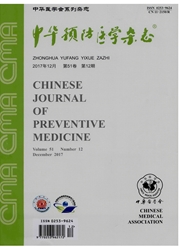

 中文摘要:
中文摘要:
目的了解汉坦病毒(HV)和恙虫病东方体(OT)可否在小盾纤恙螨体内双重自然感染及通过叮刺传播的状况。方法在肾综合征出血热(HFRS)和恙虫病混合流行区,将采集的3459只鼠体恙螨和用小黑板诱集的3265只游离恙螨,按1、5、10只螨数分组,每组叮刺6只小白鼠。15d后取小白鼠肺和脾脏制成悬液,经脑内途径接种小白鼠传6代,每代均采用间接免疫荧光法(IFAT)和Giemsa法检测HV和OT病原体;取不同恙螨数的螨制成无菌悬液接种Vero—E6细胞传代,分离检测HV和OT病原体。采用PCR法检测HV.RNA和OT—DNA。结果经传代后HV和OT双重感染鼠的检测情况为,HV单纯阳性鼠体螨5、10只组在第6代各检测到1只,OT单纯阳性鼠体螨10只组在第6代检测到1只,HV、OT双重阳性鼠体螨1只组在第5、6代均检测到1只,HV、OT双重阳性鼠体螨5、10只组在第6代各检测到1只。1、5、10只游离螨组叮刺小白鼠后,在第6代各检测到1只。Vero—E6细胞在第4代时,HV、OT双重阳性的鼠体螨5、10只螨组,各有1份检测到HV和OT双重阳性的感染细胞。传至第6代时,HV、OT双重阳性的鼠体螨1只螨组和游离螨1、5、10只螨组均检测到HV和OT双重阳性的感染细胞。经PCR检测到HV—RNA、OT—DNA。结论小盾纤恙螨体内可自然双重感染HV和OT病原体,并可经叮刺传播。
 英文摘要:
英文摘要:
Objective To investigate whether Leptotrombidium scutellare could be naturally infected by both Hantaan virus (HV) and Orientia tsutsugamushi (OT) and transmission status by stinging. Methods 3459 Leptotrombidium scutellares from mice bodies and 3265 which were free were collected in the epidemic area of hemorrhagic fever with renal syndrome (HFRS) and tsutsugamushi disease. 15 days later, the suspensions of lung and spleen of mice with 6 in a group stung by 1,5 or 10 infected mites were injected intra-cerebrally into other mice for the detection of HV and OT in the next 6 generations of the mice, with immunofluorescent antibody technique (IFAT) and Giemsa staining technique. The passages of Vero-E6 cells inoculated on the aseptic filtrations from different number of infected mites were used to detect HV and OT pathogens. HV-RNA and OT-DNA were detected by PCR. Results After passage, HV positive mouse body mite group out of both 5 and 10 mites in the sixth generation, OT positive mouse body mite group out of the 10 mites in the sixth generation, both HV and OT positive mouse body mite group out of 1 mite in the fifth and sixth generation, both HV and OT positive mouse body mite group out of 5 and 10 mites in the sixth generation, and free mites group out of 1,5 and 10 mites in the sixth generation, were found one mouse infected by both HV and OT, respectively. Out of the fourth generation of Vero-E6 cells, one sample was found both HV and OT positive out of 5 and 10 HV and OT mouse body mite group, respectively. In the sixth generation, both HV and OT positive cells were detected in one mouse mite group and the 1,5, 10 free mite groups, respectively. HV-RNA and OT-DNA were all detected by PCR. Conclusion Both HV and OT could be coexisted in wild Leptotrombidium scutellare and transmitted by stinging.
 同期刊论文项目
同期刊论文项目
 同项目期刊论文
同项目期刊论文
 期刊信息
期刊信息
